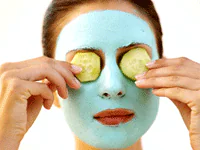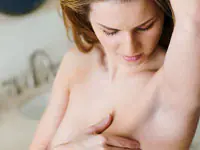Do you dream of showing off a beautiful bronze tan, but in reality you end up with blotchy skin that you want to hide under clothes? Why do freckles and unpleasant brown spots replace a beautiful, even tan? Which doctor should I contact if hyperpigmentation begins on the skin and is it dangerous? What to do if pigment spots have formed on the skin of the face, hands, and décolleté? In this case, you will have to spend several months exfoliating the damaged epidermis, whitening and nourishing the skin. What cosmetic products can be used to achieve success in the treatment of age spots?
Causes

A healthy person with normal epidermis will have an even tan. Over the entire area of the epidermis, under the influence of ultraviolet rays, the same amount of melanin pigment is produced. If the production of melanin is impaired in some areas of the skin, then spots will appear in these places or sunburn will occur.
Sunburn
A sunburn, for example after sunbathing on the back, manifests itself in the form of redness, itching, and spots on the skin. With deeper damage to the epidermis, blisters with clear liquid appear on the person’s body. The characteristic symptoms of a burn are not only damage to the epidermis and, accordingly, an uneven tan, but also an increase in temperature, headache, nausea, and weakness throughout the body. But, if you feel better after a few hours, the consequences of the burn on your face and body will remain for a long time.
Neglect of tanning rules can lead to wounds, scars and acquired hyperpigmentation.
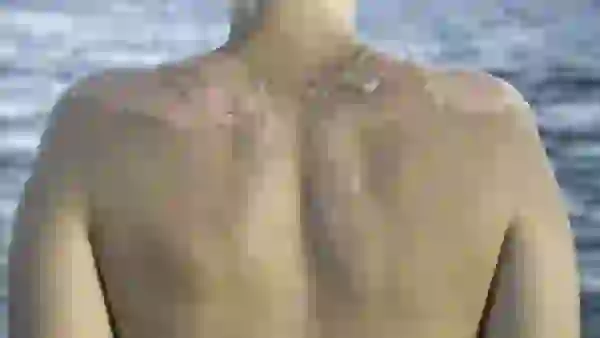
Dark spots
Dark pigment spots after tanning appear in those areas of the body where there is excess melanin production. The reason should be sought in diseases of the internal organs. Similar symptoms appear in patients with inflammatory processes of the liver and thyroid diseases. An uneven tan is observed in those who take hormonal medications or are on long-term treatment with antibiotics and antidepressants.
Before going out in the sun, it is not recommended to apply perfume to your skin or use sunscreens that have expired.
White spots
If white spots appear on the body from the sun, this indicates a pathological course in the body. Such a person does not produce melanin in the epidermis. The cause of this unpleasant phenomenon is dermatological diseases and problems with internal organs, namely:
- Vitiligo – the patient develops pigment spots after sunbathing on the face, hands and fingers. Doctors distinguish Vitiligo not as a separate disease, but as a symptom of one of the diseases of the internal organs. Vitiligo can cause disruption of the nervous system or poisoning.

Localization
Depending on the location of age spots after sunburn, a dermatologist can indicate the cause of their occurrence. If, after going to the solarium or tanning in direct sunlight, spots appear on any part of the body, then the reason is:
- Hormonal disorders in women (it is not recommended to sunbathe during pregnancy, lactation or during hormonal treatment);
- Deficiency of vitamins and microelements in the body. It is difficult for a sick body to produce a sufficient amount of melanin;
- Liver and kidney diseases;
- Infectious processes that develop with tuberculosis;
- Tumor neoplasms of the epidermis;
- Disturbances in melanin production in cells;
- Treatment with sulfonamides at the time of tanning;
- Allergy to cosmetic products that were used to protect against UV radiation.
Some solarium clients may experience increased sensitivity specifically to technical ultraviolet radiation. The tanning machine may not be set correctly and produce more UV rays than is acceptable.
How to get rid of sun spots
Getting rid of sun spots is difficult, but if you make an effort and use cosmetics correctly, it is possible. For these purposes you can:
- Contact a cosmetologist;

With the help of medical cosmetology methods - laser therapy and chemical peels, you can get rid of brown spots after an unsuccessful tan. The laser affects the cells of the epidermis - chromatophores, which are responsible for intense pigment staining. Laser therapy is considered a safe method for getting rid of hyperpigmentation. The greatest effectiveness is achieved in cases with a small area of epidermal damage.
Chemical peels are used on areas of the skin with deep lesions. The skin is exposed to acids - glycolic, malic, tartaric, lactic. The disadvantage of chemical peeling is that the patient will have to undergo a series of procedures to reanimate damaged areas of the epidermis. During the treatment period, it is strictly not recommended to be exposed to ultraviolet rays, so the procedure should be carried out in winter. Read more about peelings in this article.
You can get rid of age spots after sunbathing using whitening creams. Please note that a whitening cream containing the following components will be able to cope with the task:
- Various types of acids: ascorbic, mandelic, albatine, azelaic, koic;
- Dermawhite R complex;
- Aloesin or aloe vera extract;
- Gentesic acid ester;
- Licorice root extract;
- Acetylcysteine;
- Hydroquinone;
- Tretinol.
The most popular creams with a whitening effect are: White Effect, Melascrine, Storyderm oxygen cream, Microcellulaire, Alpha, Erborian kojic acid cream.
Prevention for skin after sun exposure
In order not to damage the skin by aggressive ultraviolet rays while tanning under the sun or in a solarium, dermatologists recommend the following prevention:
- It is better to tan on the skin in the morning before 11 o'clock and in the evening after 16. At this time, the sun's rays are not as aggressive as at noon;
- It is not recommended to be exposed to ultraviolet radiation for more than 2 hours. To get an even bronze tan, 30 minutes a day for a week is enough. Such a tan will not only cover the skin beautifully, but will also last for about a year;
- On the beach and in the solarium, be sure to use sun cream with SPF above 30. The cosmetic product should be applied not only to the face, but also to the entire body. Repeat application of the cream after each bath;
- In urban environments, it is also necessary to use sunscreens with the onset of the warm season;
- Eat right and take care of your skin. An even tan only applies to healthy skin. If the epidermis is inflamed or infected, then pigment spots are more likely to appear on it.
Choosing sunscreen
Scientific research proves that about 90% of all skin damage has one cause - the negative effects of ultraviolet rays. Tanning not only gives the skin a beautiful bronze tint, but also damages the epidermal cells at a deep level.
To protect your skin from the negative effects of tanning, you need to use a cream with SPF (sun protection factor). This abbreviation means the degree of protection against ultraviolet exposure. The SPF10 label will mean that 10% of the sun's rays will reach the surface of the epidermis. The higher the sun protection factor, the better.
Sunscreen should contain components such as: zinc oxide and titanium dioxide, benzophenone or avobenzone. These substances are chemical filters that block harmful UV rays.
Any sunscreen should be applied 20-30 minutes before going out into the sun or before you sunbathe in a solarium. Do not skimp on the product, as this may affect your health: the skin should be completely covered with a thin layer of cream.
The best cosmetics with high SPF are:
- La Roche-Posay with SPF50 is a pharmacy brand that comes in the form of a quick-drying, non-greasy product. Can be used on skin prone to allergies;
- Vichy Ideal Soleil spray is easily applied to the skin in a thin layer and does not leave a greasy residue. The product has a hypoallergenic structure and is waterproof;
- Nivea Sun Care SPF50 is a softening and moisturizing lotion that is suitable for sensitive skin.
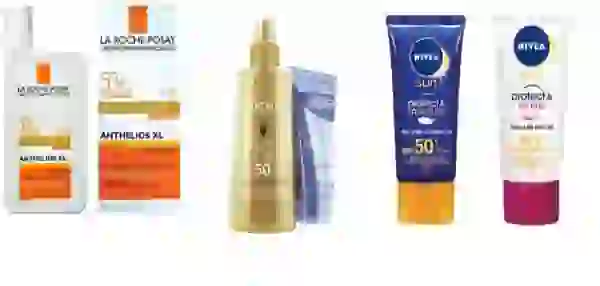
You can choose any of the sunscreens available at the pharmacy. The main thing is to pay attention to the composition and level of protection from UV rays.
If you decide to purchase a beautiful bronze tan, do not forget about preventive measures - protective cream with SPF. Sunbathing is not recommended for those people who have been diagnosed with inflammation of the kidneys, liver, or have tumors on the skin. Patients undergoing long-term treatment with antibiotics and hormonal drugs are prone to increased pigmentation.
You can get rid of existing age spots using whitening creams, chemical peels or laser therapy. Before carrying out any manipulations with the skin, we recommend that you consult a dermatologist.
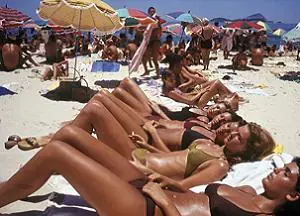
Solar lichen is a dermatological disease of a fungal nature. The skin lesion received its name due to the increase in the number of patients in the spring-autumn period.
When exposed to sunlight, the skin becomes covered with multiple spots of different shades. With “beach disease” there are no signs of the inflammatory process. Most patients are young people under 30 years of age. Sometimes “sun fungus” is registered in children.
Reasons for appearance
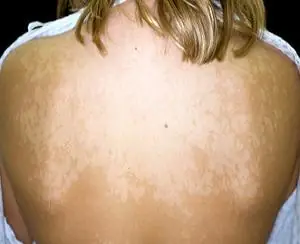
Most dermatologists are of the same opinion - damage to the stratum corneum of the epidermis and hair cuticles is caused by fungi of the genus Pityrosporum and Malassezia. Pathogens are transmitted only through close, prolonged contact from a sick person to a healthy person. The disease is low-contagious, that is, less contagious.
The risk of infection depends more on the condition of the body than on communication with infected people. After infection, several weeks sometimes pass before the first spots appear on the body. Under favorable conditions, active reproduction of fungi begins.
- decrease in the body's defenses;
- vegetative-vascular dystonia;
- diabetes mellitus, obesity;
- frequent colds;
- uncontrolled use of antibiotics;
- wearing synthetic items for a long time;
- the use of antibacterial gels that disrupt the composition of microflora and reduce the protective functions of the epidermis;
- increased sweating, changes in the composition of sweat;
- incorrect selection of cosmetic preparations for skin care;
- excessive exposure to UV rays with frequent visits to the solarium, long stays on the beach. Hence the popular name “sun fungus” or “beach disease”;
- abuse of tanning creams, which cause an allergic reaction and provoke the growth of fungi.
Some dermatologists believe that symptoms of lichen versicolor appear in patients suffering from lymphogranulomatosis and pulmonary tuberculosis.
On our website you can find out the best recipes for moisturizing masks at home.
And this article describes recipes for whitening face masks.
Symptoms and signs
“Solar fungus” has a number of characteristic features:
- Numerous round spots with uneven, clearly defined edges appear on the body;
- no pain, redness, swelling;
- spots of coffee, yellow, pinkish-brown, milky color do not rise above the skin;
- over time, areas of a different color grow, sometimes to the size of the palm of an adult;
- When rubbing the affected areas, particles of the epidermis peel off.
Main locations:
In young children and adolescents, the manifestations of “beach sickness” are located on:
- hands;
- legs;
- armpits;
- on the scalp.
A characteristic symptom of “beach sickness” is that during exposure to the sun, UV rays do not affect the affected areas. These areas do not tan and stand out noticeably against the background of healthy areas.
Methods of treating the disease
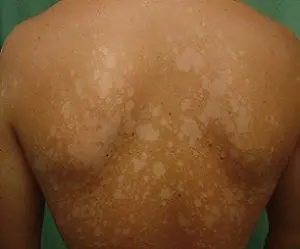
The disease has pronounced symptoms, but You should not prescribe treatment yourself. Do not use antifungal ointments until you consult a doctor. You can “smear” the manifestations, causing uncontrollable changes in the skin with improper therapy.
Visit a dermatologist. In most cases, the specialist does not limit himself to a visual examination, but prescribes additional tests. Specific studies will help make an accurate diagnosis:
- dermatoscopy of solar lichen spots;
- luminescent diagnostics. Under a Wood's lamp, which is used to determine many dermatological diseases, pathogenic fungi glow with certain colors and shades;
- Balzer iodine test. After the test, the affected skin looks much darker than healthy areas;
- microscopic analysis of the contents taken from the stain area. After tests, the causative agent of a fungal disease is detected in particles of the epidermis;
- test confirming Besnier's symptom. In case of pityriasis versicolor, even a slight impact produces results - the scales of the epidermis are suitable for research. It is very difficult to collect particles of the stratum corneum from healthy skin;
- A general blood test is required.
Sometimes PCR diagnostics are required to differentiate from other skin diseases. If syphilis is suspected, an RPR test is performed to confirm or refute the presence of Treponema pallidum.
How to get rid of sun lichen? Main methods of treatment:
- local therapy;
- use of traditional medicine recipes;
- prescription of general strengthening drugs;
- preventive measures.
Dermatologists recommend treating affected areas with safe products that have proven their effectiveness. Your doctor will prescribe one of the local remedies that suits you.
Lubricate lichen spots:
- Resorcinol alcohol;
- Clotrimazole;
- Salicylic ointment;
- Terbinafine;
- Sulfur ointment;
- Cycloperox;
- Naftifin;
- Salicylic alcohol;
- Lamisil.
Among the names of antifungal agents are creams, solutions, and ointments for sun lichen. Some drugs are available in different concentrations, for example, resorcinol alcohol, sulfuric ointment, salicylic ointment. Only the doctor decides which medicine to give preference to.
- test results;
- affected area;
- individual tolerance of certain antifungal compounds.
Most dermatologists recommend modern antimycotic drugs in the form of solutions, lotions, and sprays. Advantages:
- high-quality treatment of every millimeter of lichen spots;
- uniform application regardless of the location of the affected areas;
- absence of an oily film on the skin, which is created by preparations in the form of a cream. In the warm season, this factor is very important.
In addition to local treatment, general therapy is recommended in advanced cases. The following drugs are designed to suppress the activity of fungi:
Taking Cycloserine will help restore normal pigmentation of the affected areas. The drug has earned a lot of positive reviews.
How long does treatment last? The sooner you see a doctor, the sooner you will get rid of fungal infection of the epidermis. With the correct selection of local remedies and the simultaneous use of oral medications, the condition improves quite quickly.
A late visit to a dermatologist can result in unpleasant consequences:
- treatment is delayed;
- often a bacterial infection is associated with a fungal infection;
- requires the use of antibiotics that weaken the immune system;
- side effect of antibacterial therapy - with reduced immunity, there is a high risk of relapse of the “solar fungus”.
Folk remedies and recipes
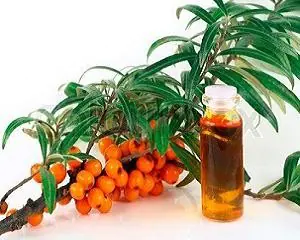
Supplement your therapy with proven home remedies. Do not replace, but complement. Unfortunately, not all patients follow these recommendations; they self-treat with herbs and ointments and wonder why there is no result.
Only after consultation with a dermatologist can you use traditional medicine recipes. Remember - the basis of treatment is antifungal ointments, and if necessary, systemic therapy.
How to cure sunburn at home? Proven recipes:
- sea buckthorn oil. Treat affected skin with undiluted product 2 times a day. You can add a few drops of healing oil to any nourishing cream and lubricate lichen spots. Sea buckthorn oil has a healing, soothing effect;
- rosehip infusion. An excellent remedy that strengthens the immune system. Pour 2 tbsp into a thermos. l. fruits, pour in 0.5 liters of boiling water. After two hours, strain the infusion. Take half a glass orally twice a day. Some herbalists recommend treating spots with “sun fungus” with infusion;
- wild or horse sorrel. Finely chop a bunch of leaves and combine with a tablespoon of sour cream. Apply the paste onto the stains and wash off after 15 minutes;
- Apple vinegar. Only a high-quality product is suitable for treating lichen spots. Every three hours, wipe away any blemishes on your body with apple cider vinegar. Watch the reaction. If itching or severe peeling occurs, stop the procedure;
- rosehip oil. Buy healing oil at the pharmacy. Apply to affected areas twice daily.
How to treat irritation under the arms? We have the answer!
On this page you can learn everything about treating acne on the head.
At this address, read useful information about folk remedies for urticaria in adults.
Solar lichen in children
Toddlers and older children also develop multi-colored spots caused by a fungal infection. Symptoms of fungal skin infections are similar to those of sunburn in adults.
There are several causes of the disease:
- allergic reactions to sunlight, which provoke the proliferation of fungi;
- exposure to direct sunlight. A short period of time is enough to damage delicate baby skin;
- weakened immunity. One of the reasons is frequent respiratory infections.
In children, areas with unusual pigmentation appear:
- on legs, arms;
- in the armpits;
- on the scalp.
If strange spots appear, be sure to visit a dermatologist. The doctor will order tests and recommend antifungal medications based on the child’s age. Timely initiation of therapy will allow you to quickly cope with the disease.
Preventive recommendations

Fans of chocolate tans should think carefully: “Do you need to spend the whole day on the beach?” You can purchase not only “sun fungus”, but also other types of photodermatosis. Long hours in the sun provoke the growth of moles, lead to the formation of age spots, and cause sunburn.
Following simple rules will prevent the occurrence of a fungal infection, which is “beach disease.” Prevention measures:
- do not visit the solarium;
- Avoid using antibacterial soap or shower gel every day;
- sunbathe in the morning and evening hours, stay more in the diffused shade of green spaces;
- In summer, do not go outside without a special cream with UV filters. After therapy, protect not only the face, but also other open areas of the body with the composition;
- take care of your health, strengthen your immune system;
- in hot weather, do not wear clothes made of synthetic fibers;
- in case of excessive sweating, treat skin folds and armpits with powder, talcum powder, and wipe with a decoction of oak bark;
- control the course of endocrine system diseases;
- treat heart pathologies, strengthen blood vessels.
The following is a medical video - a reference book from which you can learn a few more home recipes for the treatment of tinea versicolor or solar lichen:
Did you like the article? Subscribe to site updates via RSS, or follow updates on VKontakte, Odnoklassniki, Facebook, Google Plus or Twitter.
Subscribe to updates by E-Mail:
Tell your friends!
Beach disease or sun lichen: photos, symptoms, treatment in adults and children: One comment
When such a misfortune appeared, I was sure that during the winter it would go through the same thing, but no. in the summer the spots again, only even more. I had to urgently look for a solution. The choice fell on Terbinorm spray, my husband quickly cured the fungus on his feet with it and fortunately Terbinorm helped me too, and most importantly, very quickly
Sun or beach lichen is a type of fungal infection of the epidermis. The population of pathogenic microflora that provokes the development of the disease rapidly increases under the influence of sunlight, so the disease develops in the warm season. The disease is non-contagious and harmless, but requires timely treatment, otherwise the lichen progresses, affecting increasingly larger areas of the epidermis.
Symptoms of the disease
In order to detect the disease in a timely manner, you should know what solar lichen looks like. With this fungal infection, spots form on the body, mostly brown in color. Sun spots on the body do not itch, hurt or swell. The spots are flat, regular in shape, they differ from healthy skin only in color.
Often people notice peeling of the epidermis in the affected area. In this case, large scales may be separated, but no discomfort is observed.
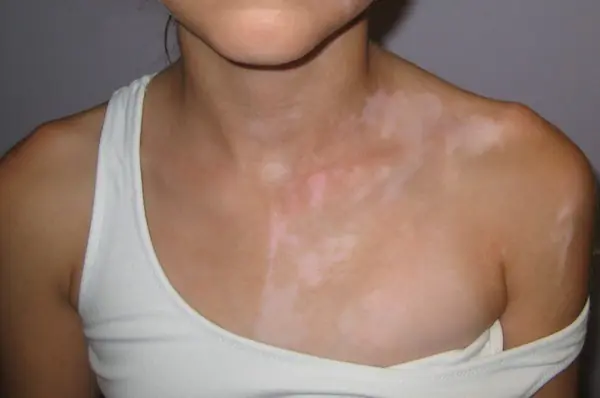
Sun spots are caused by a fungal infection. This fungus begins to actively multiply in the presence of the following diseases:
- dysfunction of the autonomic nervous system;
- metabolic disease;
- diseases of the gastrointestinal tract;
- hormonal disbalance;
- decreased immunity;
- violation of skin microflora;
- damage to the epidermis.
The disease manifests itself as unaesthetic spots. Pigmentation in the affected area has all shades of brown; milky white and light pink spots of regular shape are often formed.
At the beginning of the development of the disease, the spots are small in size. When exposed to ultraviolet rays, there is a tendency for spots to grow. As a result of prolonged exposure to the sun, the spots merge into large areas with impaired pigmentation. Ringworm can reach the size of an adult's palm.
Most often, the lesion appears on the skin of the back, chest and sides. Young people under 30 years of age experience the disease.
Such spots on the skin do not tan, which makes it possible to accurately distinguish solar lichen in humans from other fungal infections of the epidermis.
Drug treatment
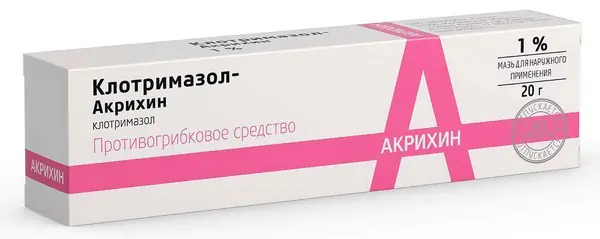
How to treat solar lichen depends on how large the spots are. At the initial stage of development of a fungal disease, the affected areas are treated with ointments. If the affected area is large, general restorative drugs and systemic antimycotics are additionally prescribed.
Ringworm treatment that is started in a timely manner goes away within a few weeks, but it takes a long time to restore skin pigmentation. Treatment for sun fungus should be prescribed by a dermatologist after conducting appropriate tests. To determine the type of pathogen, a skin scraping must be taken for examination.
Treatment of solar lichen at home is carried out using broad-spectrum antifungal ointments. The most commonly used ointment is Clotrimazole. This drug acts directly on the life cycle of pathogenic microflora, preventing the fungus from spreading to healthy areas of the skin. The auxiliary components of the drug help soften the epidermis and eliminate flaking. The medicine also has an antiseptic effect, preventing infection of the affected areas of the skin.
Another effective antifungal drug is Terbinafine ointment. The medicine is applied to the affected areas several times a day.
Lamisil cream is also used to treat various mycoses. The oily consistency of the drug promotes rapid absorption of the medicine and nourishes the skin, which helps get rid of flaking.
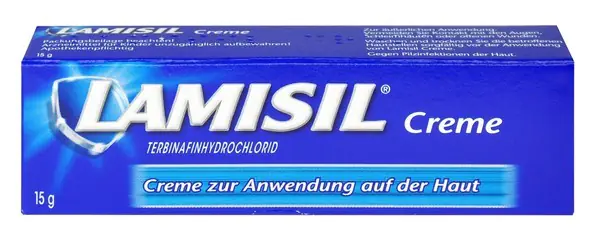
What antifungal ointment to use for sun lichen is decided by the doctor based on the results of the examination.
To quickly cure solar lichen, the following drugs are additionally used:
- salicylic alcohol;
- salicylic ointment;
- zinc paste;
- ointment with sulfur.
Salicylic alcohol or salicylic ointment helps speed up the process of restoration of the epidermis in the affected area. These drugs additionally have an antiseptic and keratolytic effect, accelerating the renewal of the upper layer of the epidermis.
Zinc paste effectively softens the skin and accelerates regeneration. Sulfur ointment can be used to further soften the skin.
If, several weeks after the start of treatment, the symptoms do not go away, antimycotics in tablets are additionally prescribed. For this purpose, Flucanazole or Nystatin is used. The duration of treatment and the dosage regimen depend on the severity of the damage to the epidermis and are selected by the doctor individually for each patient. Such drugs have a systemic effect on the entire body as a whole, so it is not recommended to take them on your own.
Treatment is supplemented with immunostimulants. Often, for fungal skin lesions, echinacea tablets are prescribed.
Folk remedies
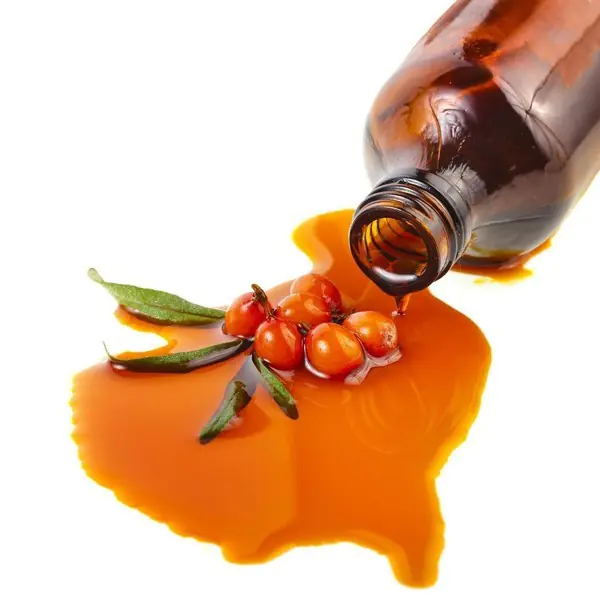
Traditional medicine knows how to treat solar lichen. This treatment at home is recommended for use at the initial stage of pathology development, when the spots are small in size.
- Sea buckthorn oil helps speed up skin regeneration and stop the spread of fungus. This product should be rubbed into stains twice a day. Sea buckthorn oil helps both cure sunburn and prevent the spots from reappearing. For preventive purposes, it is recommended to use it once every three days for two weeks after the symptoms disappear.
- Apple cider vinegar compresses are used to treat any mycoses. Vinegar should be mixed with water in equal proportions. Then a compress is generously moistened in the product and applied to the skin for half an hour. The procedure should be repeated three times a day; there is no need to wash off any remaining product.
- Rosehip decoction helps improve the protective function of the skin and accelerates regeneration. It can be used both to treat fungus and to accelerate the restoration of pigmentation in affected areas of the skin. To prepare the decoction, add three large spoons of dried berries to two glasses of water and cook over low heat for 20 minutes. After the medicine has cooled, soak a cotton swab or gauze compress in it and apply it to the skin for 30 minutes. The procedure is carried out in the morning and evening.
- Rosehip oil also helps speed up skin restoration. The product should be rubbed into the stains twice a day.
To quickly get rid of the disease, it is recommended to use traditional recipes in addition to drug therapy. Before using any product to treat ringworm, you should consult your doctor.
Skin treatment should be carried out for a long time, even after the symptoms of the disease disappear. For preventive purposes, you need to treat the epidermis with ointments or oils every three days for 15 days after the symptoms of the disease disappear. This will prevent the recurrence of sunburn in the same areas of the skin.
During treatment, you should apply sunscreen before going outside. To reduce irritation to the affected epidermis, it is recommended to use talc and baby powder to reduce sweating in the area affected by the fungus.



